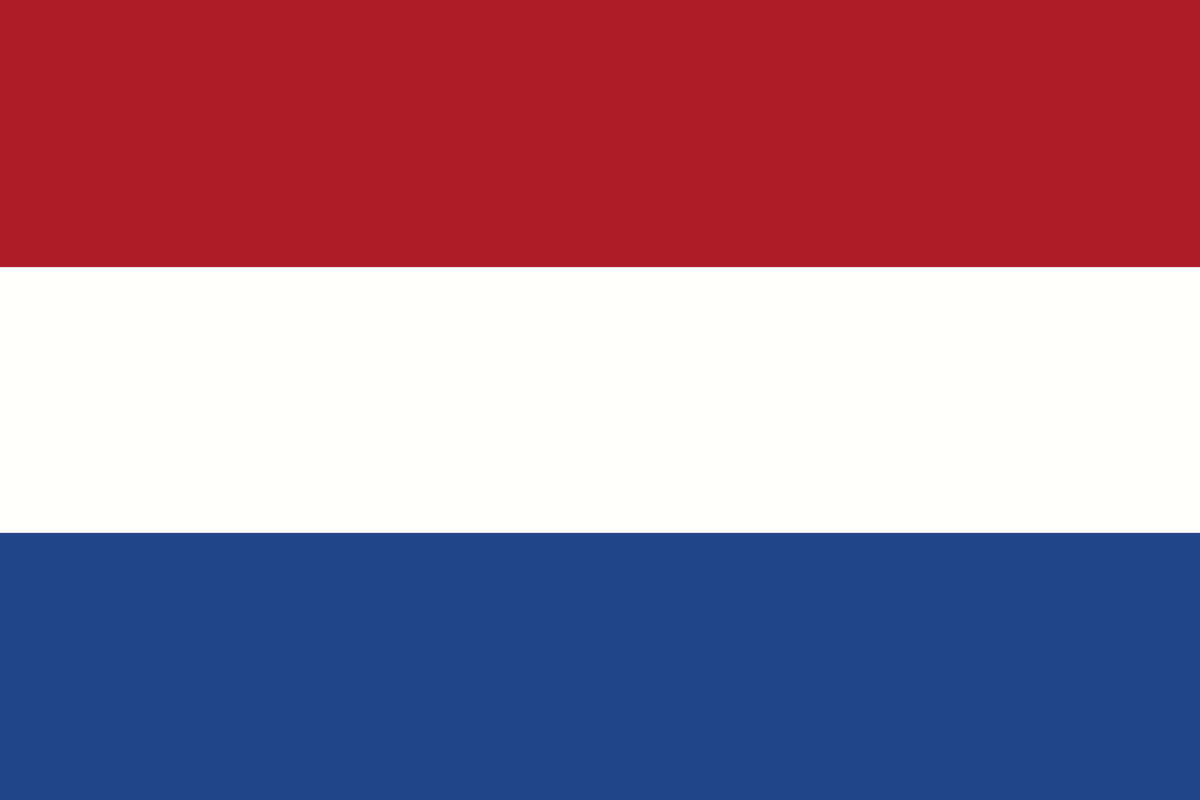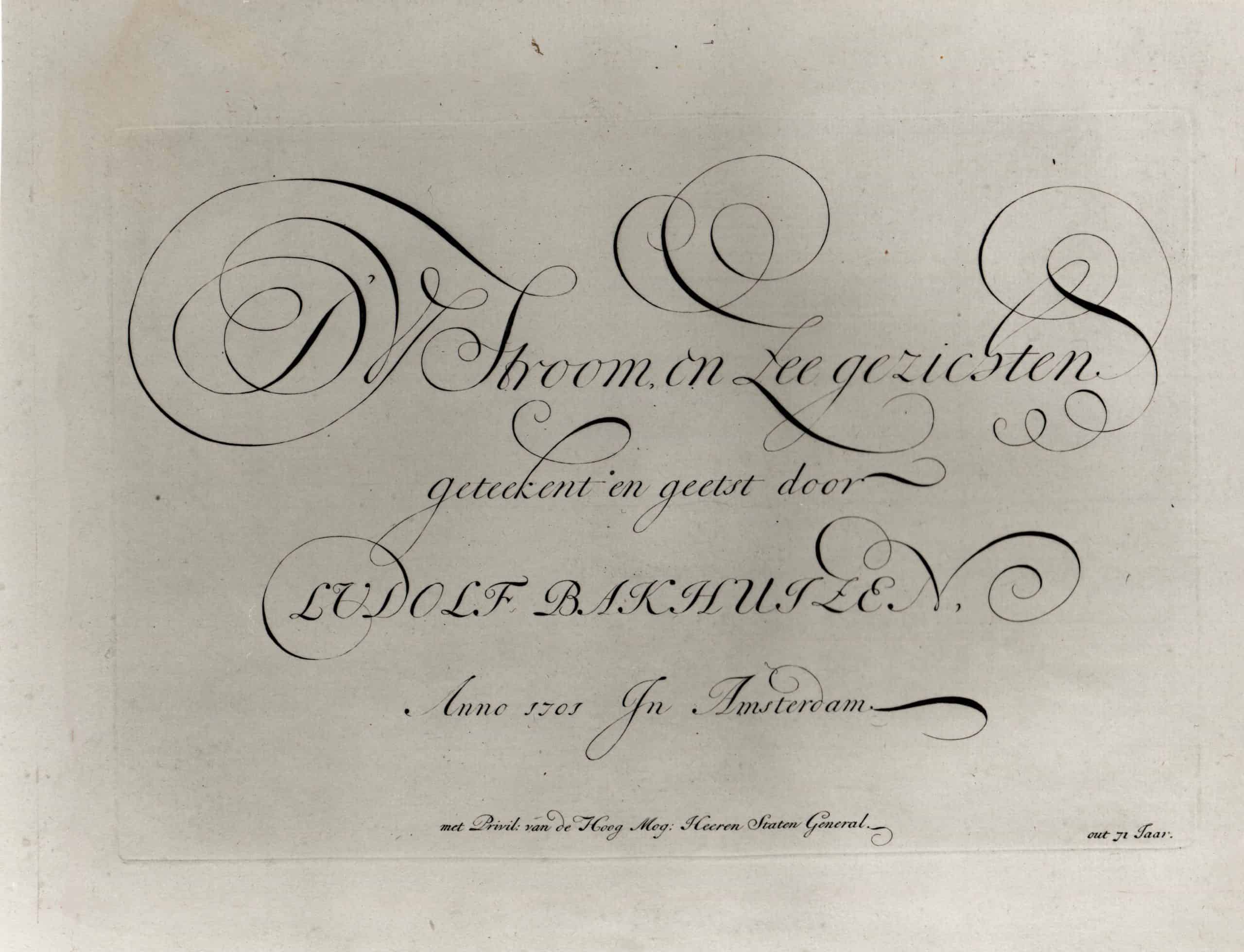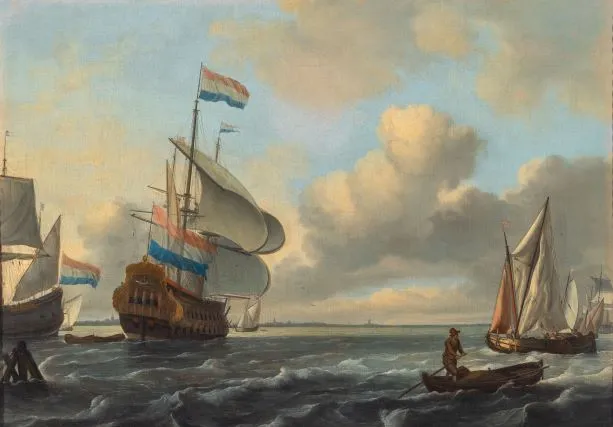Ludolf Backhuysen
Ludolf Backhuysen (Emden 1631-1708 Amsterdam), is considered one of the most important marine painters of the seventeenth century, besides being an excellent draughtsman and etcher. His awe-inspiring creations reflect the heart of the Dutch Golden Age of seafaring, illustrating the intricate details of ships and the vast, powerful sea that embraces them.
Biography Ludolf Backhuysen
There is not much known about Backhuysen’s early years, but it is known he came from Emden, Germany and set sail for Amsterdam in the early 1650s. He first works as a clerk for the firm of the wealthy merchant Guilielmo Bartolotti van den Heuvel, a fellow native of Emden. He embarked on his artistic voyage as a calligrapher and from 1650 onwards he was also working as a draftsman, producing “pen paintings” or grisailles, in which the influence of Willem van de Velde the Elder is clearly seen. As late as 1657 and 1660, he is still referred to in documents as a draftsman, and although his earliest dated oil painting was executed in 1658, he did not join the painters’ guild until February 1663. He was mainly self-taught, although he visited the studios of
Dutch marine artists like Allart van Everdingen (1631-1675) and later Hendrik Dubbels (1620/1621- 1676?), to study and discuss the art of painting. He honed his skills and soon gained recognition for his portrayal of the sea. By the late 1660s, admiralties and maritime merchants sought him out for commissions, solidifying his reputation as a gifted painter.
Despite his late start as a professional painter, Backhuysen rapidly gained widespread fame and patronage. The dignified background of Backhuysen and the marriage of several woman of standing in his life also contributed to increase his fortune and ability to attract a wealthy clientele such as Peter the Great of Russia, the king of Prussia, the elector of Saxony, and the grand duke of Tuscany. In the winter of 1672-1673 his main competition the Van de Veldes set sail for England, which would make him the most important marine painter in the republic.
Artistic Style and Influences
Ludolf Backhuysen’s artistry was deeply rooted in the Dutch Golden Age and the marine painters who came before him, such as Simon de Vlieger and Willem van de Velde the Elder. His meticulous eye for detail, particularly when it came to accurately representing ships and their rigging, became a trademark of his work. Backhuysen was an ardent study of nature and the meteorologic phenomena and his paintings are marked by dynamic realistic compositions with audacious contrasts.
Allegedly, Bakhuysen sought out the water in bad weather in order to properly study the effects of weather on air and water. He usually painted on canvas on large format and his subjects vary from sea – and rivers scapes to showpieces based on historical fact of fantasy often with a staffage of colourfully dressed people on board the ships or in the foreground, and the storms and shipwrecks he was renowned. Backhuysen’s paintings often depicted intense scenes of ships navigating tumultuous seas and stormy weather, symbolizing both the perilous nature of seafaring and the sublime beauty of the natural world. His deft use of chiaroscuro and atmospheric perspective imbued his seascapes with a sense of depth and drama.
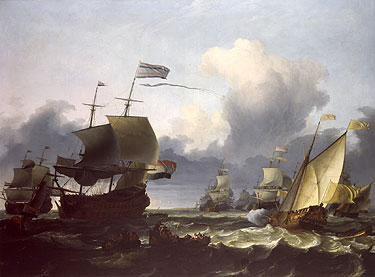
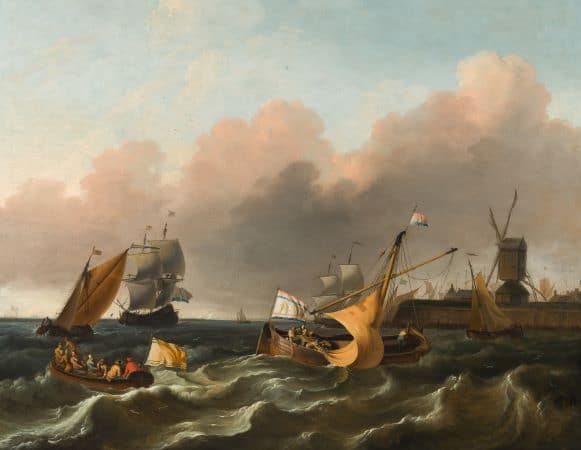
(Emden 1630 – 1708 Amsterdam)
Ships on de IJ river (Amsterdam) off the Leeuwenberg jetty and the windmill ‘De Bok’
Oil on canvas: 64 x 77 cm
Signed with initials on the flag l.c.: L.B.: Y
Indistinctly signed and dated on the barrel l.r: L Ba.h /1704
Provenance: United Kingdom, private collection
Rob Kattenburg Collection
Exhibitions and Collections
Ludolf Backhuysen’s artistic treasures grace the halls of esteemed museums and galleries around the globe, including the Rijksmuseum in Amsterdam, the National Gallery in London and the Hermitage Museum in St. Petersburg.
Related Products
“D’Y stroom en Zeegezichten”/ getekent en geëtst door LUDOLF BAKHUIZEN/ Anno 1701 In Amsterdam
Complete series consisting of:
Title page, etching by L. Backhuysen
Portrait of Backhuysen, Mezzotint by J. Gole
And 10 pages of etchings by L. Backhuysen
plus a hymn by J. van Broeckhuysen, on a separate plate
Further reading and resources
For those eager to delve deeper into the world of Ludolf Backhuysen and the Dutch Golden Age of maritime painting, we recommend the following resources amongst others:
“Dutch Seascapes of the Golden Age” by George S. Keyes
This book offers a fascinating exploration of the history of Dutch marine painting, with insightful commentary on Ludolf Backhuysen’s work and his contemporaries.
“Masters of the Sea: Dutch Maritime Painters of the 17th Century” by Laurens J. Bol
Bol’s book provides an extensive study of Dutch maritime painters of the 17th century, examining their techniques, influences, and the significance of their work within the context of the Golden Age.
Literature:
- G. de Beer, Ludolf Backhuysen (1630-1708): sein Leben und Werk, Zwolle 2002
- G. de Beer, E. J. Goossens & B. van de Roemer,exhib. cat. Backhuysen at the helm! Marine Painter, 1630-1708 Amsterdam (Royal Place) 2004
- L.J. Bol,Die Holländische Marinemalerei des 17. Jahrhunderts, Brunswick 1973
- J. Giltai and J. Kelch, exhib. cat. Praise of Ships and the Sea: The Dutch Marine Painters of the 17th Century, Rotterdam (Museum Boijmans van Beuningen) & Berlin (Staatliche Museum zu Berlin)
- C. Hofstede de Groot: A Catalogue Raisonné of the works of The Most Eminent Dutch Painters of the Seventeenth Century. London 1923
- S. Kattenburg, View of Amsterdam with ships on the river IJ, in the middle the elaborately decorated city yacht: a capital painting by Ludolf Backhuysen, Bergen 2018
- G.S. Keyes, et. al., Mirror of Empire. Dutch Marine art of the seventeenth Century , The Hague, 1990
- R. Preston, The seventeenth century marine painters of the Netherlands, Leigh on sea 1974
- F. C. Willis, Die Niederländische Marinemalerei, Leipzig 1911
Conclusion
As a leading figure in Dutch maritime painting during the Golden Age, Ludolf Backhuysen’s work has left an indelible mark on the art world. His intricate, dramatic seascapes not only encapsulated the spirit of the Dutch seafaring era but also showcased the awe-inspiring beauty and power of the natural world. Through this pillar page, we hope to have provided you with a comprehensive insight into the life, influences, and remarkable creations of this extraordinary painter.
For further inquiries or assistance feel free to contact us.


